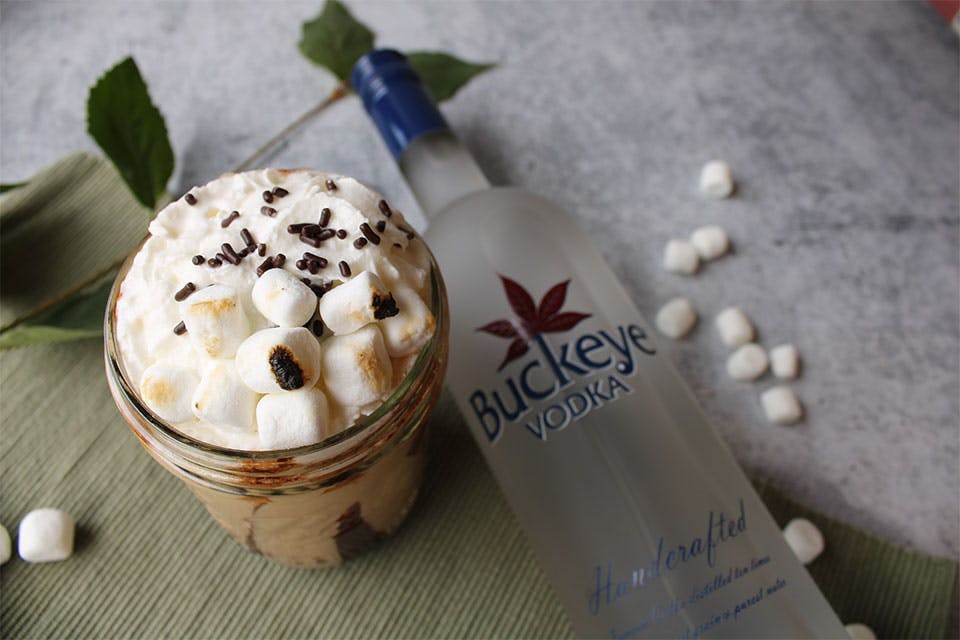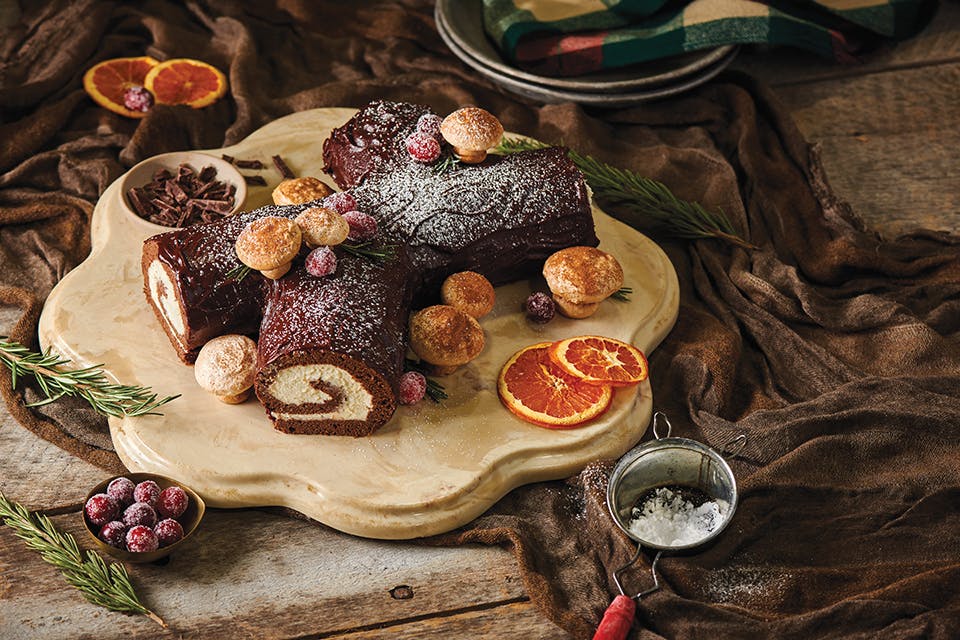Berry Bonanza
Red and black raspberries grow in abundance in Ohio. Pick your own, then try our delicious raspberry recipes.
August 2013 Issue
BY Jill Sell | ART BY
August 2013 Issue
BY Jill Sell | ART BY
Mark Stokes stands in the middle of his family’s 230-acre Stokes Berry Farm in Wilmington, under a gorgeous bright blue sky with fluffy clouds. A gentle breeze ruffles rows of black raspberry plants growing under a warm sun. The idyllic scene looks almost like a staged poster for Ohio berry production — a young, fit-looking grower surveying a crop that many call “the king of berries” because of their outstanding health benefits.
Things may look peaceful during the day, but Stokes says some nights aren’t quite as calm. When he drives his pickup truck to the fields after dark and illuminates the rows, he sees “eyes shining back.”
“Raccoons stand up on their hind legs and just pick berries right off the plant,” says Stokes. “They think we grow berries for them. Raccoons just love raspberries.”
Well, what’s not to love? Red raspberry mousse is decadent, black raspberry pie to die for and cheesecake with a drizzle of raspberry sauce is downright sinful. And berries taste awfully good right off the plant. Americans consider raspberries their third favorite berry, after strawberries and blueberries.
But there is some disagreement among raspberry lovers.
“I was surprised at the strong preference some people have for either black or red raspberries. I like both,” says Gary Gao, extension horticulturist and associate professor with Ohio State University South Centers in Piketon. “Ohio is actually well-known for [growing] black raspberries, which have more seeds and very mean thorns.”
Yellow (golden) raspberries, which have more red- than black-like attributes, and purple raspberries (a hybrid of red and black) are also grown in Ohio, but on a smaller scale.
Fresh raspberry consumption is up almost 300 percent in the U.S., according to Gao, who is working to improve Ohio’s production.
With some 42 acres of black raspberries, Stokes Berry Farm is the “largest, privately owned black raspberry grower east of the Mississippi,” claims Dale Stokes, Mark’s father, who planted his first black raspberries in 1962. He added red raspberries in 1975. Currently the farm grows six acres of red, purple and yellow raspberries.
“We have sold raspberries every year since the beginning,” says Dale, who owns the farm with his wife, Jane, son and daughter-in-law, Stephanie.
The farm has a pick-your-own operation when berries are in season and also sells pre-picked berries. A huge harvester is used to pick black raspberries that will be frozen, shipped to Illinois to be freeze-dried and made into raspberry powder. Since 1992, a portion of that powder has been used by the Arthur James Cancer Hospital at Ohio State University.
Researchers study black raspberries’ connection in helping prevent esophageal and colon cancers. A number of additional studies have shown raspberries to have excellent antioxidant and anti-inflammatory benefits.
OSU researcher Thomas Knobloch says freeze-dried black raspberries have been shown to inhibit oral cancer formation in animals and humans. Unripe, green black raspberries are also effective.
In addition, Stokes Berry Farm collaborates with the University of Maryland in breeding programs to improve plant and fruit quality. About 14,500 baby raspberry plants make up the farm’s greenhouse nursery.
Raspberry seasons don’t last long in Ohio. Fresh summer raspberries are mostly gone now. But fall crops begin to ripen about mid-July and are usually available until a frost. Always check online or call a farm for its current berry availability. If you pick your own, choose only ripe berries. Raspberries don’t ripen off the plant. The fruit should fall into your hand with just the gentlest of persuasion. If you have to pull, the berry isn’t ripe.
Wash berries just before you use them. Three days in the fridge is about tops. A quick way to freeze berries is to place them individually on a cookie sheet in the freezer. When frozen, transfer berries to a freezer bag.
Jane Stokes says why you use berries determines how they should be frozen. She suggests packing gently rinsed black raspberries for baking (pies and cobblers) into containers using 1/4 cup sugar per pint of fruit. Freeze dessert black raspberries that will not be cooked in containers topped off with a syrup made from 1 cup sugar and 2 1/2 to 3 cups water.
For dessert purposes, sprinkle one pint of red raspberries to be frozen with 1/4 cup sugar. Stokes also suggests not sweetening either red or black raspberries that will be frozen to make jams or jellies.
Products featuring Ohio raspberries in jams, jellies and relishes are available at farmers markets and grocery stores long after the last berry is picked. In addition to selling fresh berries, Ann’s Raspberry Farm & Specialty Crops in Fredericktown makes several red raspberry products “from seed to jar.” Think Chocolate Raspberry Artisan Jam and Jalapeno Raspberry Artisan Jam.
Ann and Daniel Trudel, owners of the farm that is chemical-free, have won six prestigious, national Good Food Awards for their creations, including a 2013 award for their Red Raspberry Artisan Jam. The Trudels began growing raspberries in 2004 and now use a “high tunnel” method of growing plants under a protective covering. Daniel Trudel says the method increases yield 10 times over field-grown raspberries.
The Trudels say their decision to become raspberry growers was primarily based on economic research. But Ann fondly recalls picking raspberries as a child in Michigan.
“That was the inspiration. Now we are passionate about raspberries,” she says.
How and What to Grow
Raspberries are either summer-bearing or ever-bearing (also called fall berries). Summer-bearing plants produce one crop in early summer, and ever-bearing can produce one crop in fall and one in spring. Gary Gao, OSU extension horticulturist and associate professor, says compared to black raspberries, the red tend to be “more cold hardy, have larger berries and more erect canes.” Black raspberries have “seedier, smaller berries and arching canes.”
Heritage, developed in the 1960s, is a favorite ever-bearing, high-yielding red raspberry with medium-size fruits and good flavor. Among the newer varieties of reds, Gao likes Carolina, which fruits a little earlier than Heritage and has larger berries. He also suggests Joan J, a large, thornless ever-bearer that produces many berries. Also try Latham, a red summer bearer, with “small fruits with good color and fair flavor.”
Gao suggests Bristol, a vigorous black raspberry with large fruits, that is the leading Ohio producer. Jewel is another top black choice. Fall Gold is for those who want to try yellow raspberries.
For no-ouch plants, Raspberry Shortcake is a new thornless dwarf red raspberry that is good for container gardening. No staking or trellis is needed.
Gao encourages raised beds or planting on ridges for better drainage. Sandy loam soil with added organic matter is best, but raspberries are pretty forgiving about soil types. Plants need six to eight hours of sunlight and to be free of weeds. Some pruning is mandatory, otherwise “you will have one huge mess, poor fruit quality and fruits that don’t taste as sweet,” according to Gao.
Many home gardeners want to grow both red and black raspberry plants. Gao says that works if the plants aren’t right next to each other, which could cause shared viral diseases. One color in the back yard, another in the front is fine. If space limitations prevent that arrangement, plants can be grown closer together, but Gao says to be prepared to buy new plants after several years.
Several raspberries are native and/or wild to Ohio, and home gardeners can have some success with cuttings if garden conditions are right. The grayleaf red raspberry ( Rubus strigosus) is found growing in colonies. It is a favorite food of songbirds and mammals, including humans. The berry is eaten fresh, used in jams or jellies and its leaves are used to make tea. Bees especially love the wild American red raspberry (Rubus idaeus). The black raspberry (Rubus occidentalis) begins as a red berry that turns black when ripe. This berry can also be eaten, but it is tough to get past those thorns during picking.
***
When You Go
The following are sources for raspberries, both prepicked and pick-your-own, and raspberry products. Call in advance to make sure raspberries are available.
Ann’s Raspberry Farm & Specialty Crops
6645 Blair Rd., Fredericktown 43019
740/694-1935, annsraspberryfarm.com
(red raspberries, plants, jams, sells on-site and at farmers markets)
Champaign Berry Farm
5676 E. St. Rte. 29, Urbana 43078
937/232-7525, champaignberryfarm.com
(red and black raspberries, sauces, jams, pick-your-own, farmers markets)
Moreland Fruit Farm
1558 W. Moreland Rd., Wooster 44691
330/264-8735, morelandfruitfarm.com
(red, black and purple raspberries; prepicked; pick-your-own; summer berries only)
Rosby Berry Farm
42 E. Schaaf Rd., Brooklyn Heights 44131
216/661-6102, rosbycompanies.com
(red raspberries, pick-your-own, prepicked)
Shari’s Berries and Garden
12210 Abbott Rd., Hiram 44234
330/569-7882, sharisberriesandgarden.com
(red raspberries, plants, pick-your-own, pre-picked, farmers markets)
Stokes Berry Farm
2822 Center Rd., Wilmington 45177
937/382-4004, stokesberryfarm.com
(black, red, purple and yellow raspberries; pick-your-own; frozen black raspberries; freeze-dried black raspberry powder)
***
Raspberry Ice Cream
Courtesy home economist Jane Rogers | Serves 4
INGREDIENTS
2 pints (or 2 1/3 cups) red raspberries
(or 10-ounce bag frozen unsweetened raspberries)
1/2 cup whipping cream
2 tablespoons sugar (or more to taste)
2 tablespoons packed brown sugar
1 teaspoon pure vanilla
DIRECTIONS
Freeze fresh berries for several hours or overnight. Place frozen raspberries and all other ingredients into a high-speed blender and blend until smooth. Serve as is or keep in freezer until ready to serve. Garnish with a few reserved fresh berries.
For seedless ice cream: Use fresh raspberries or thaw frozen berries. Place berries only in high speed blender and blend well. Place mixture in a fine sieve and press the mashed raspberries through the sieve, discarding seeds and solids left in sieve. Freeze mashed berries for several hours or overnight. Place the mashed berries and remaining ingredients into blender and follow directions as above.
Raspberry Parfait
Courtesy home economist Jane Rogers | Serves 4
INGREDIENTS
1 cup whipping cream
1 cup sour cream
1/2 cup sugar
1 teaspoon vanilla
2 tablespoons freshly squeezed lemon juice
2 pints red raspberries
DIRECTIONS
Place all ingredients except raspberries into food processor and spin until well blended and somewhat thickened. Or place ingredients into bowl and whisk thoroughly. (This parfait mixture will not whip into a true whipped cream consistency.)
Place a few berries in the bottom of each serving dish. Add a layer of the parfait mixture. Repeat layers. Top with additional berries to garnish and serve.
Parfait mixture can be made ahead and refrigerated for three days. It is best to prepare parfaits with fruit right before serving.
Related Articles

Buckeye Vodka Shares 3 Summer Cocktail Recipes
We teamed up with Dayton’s own Buckeye Vodka to bring you some mixed drink inspiration. Try this trio of light, delicious offerings at your next summer party. READ MORE >>

5 Holiday Recipes to Make Together This Season
From simple gingerbread cookies that leave lots of room for creativity to a beautiful Buche de Noel that is sure to grab attention, these creations offer fun baking projects. READ MORE >>

7 Cocktail Recipes that are Perfect for Summer
Celebrate by shaking up these festive cocktails that pair well with parties and picnics all season long. READ MORE >>


